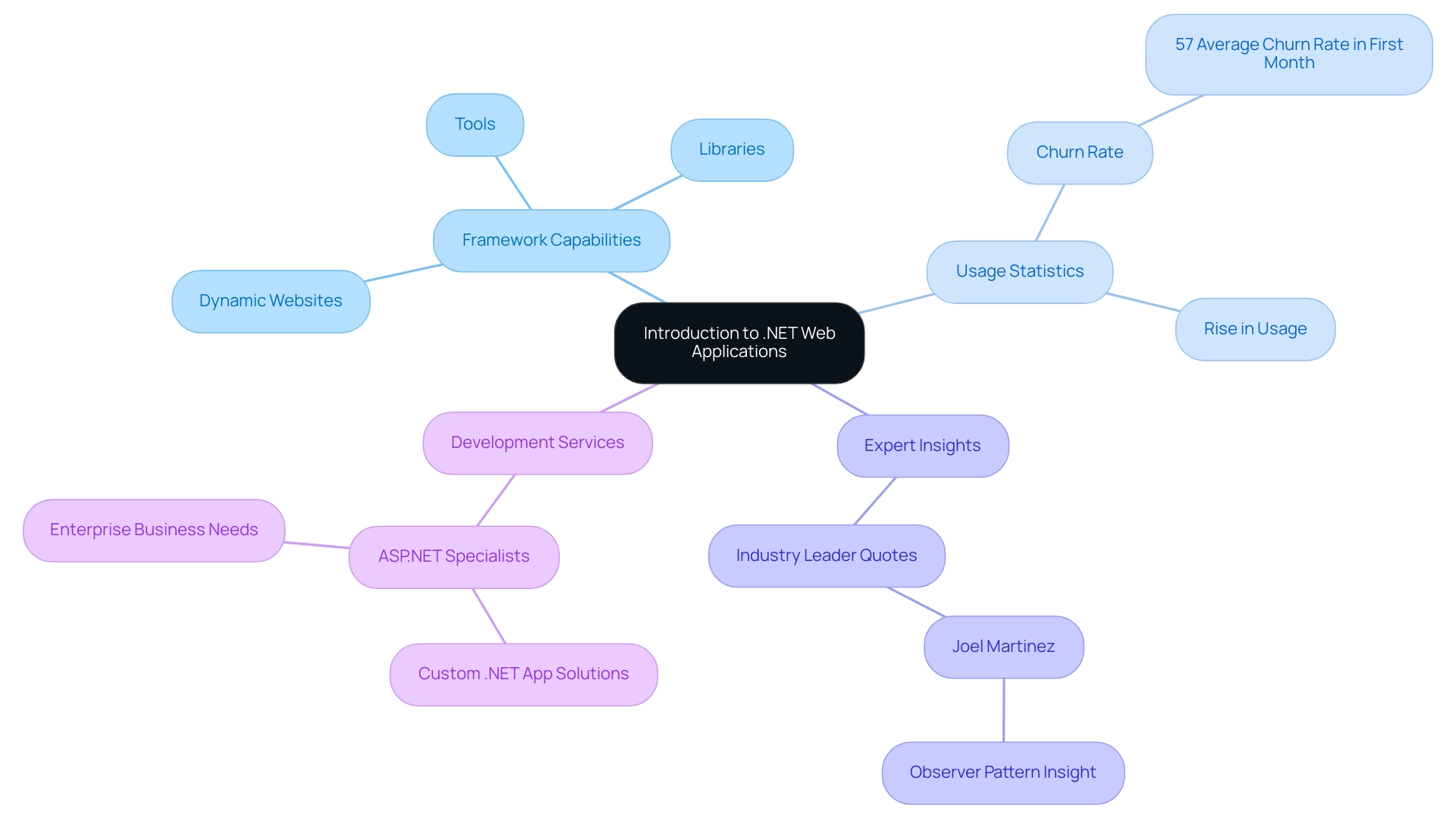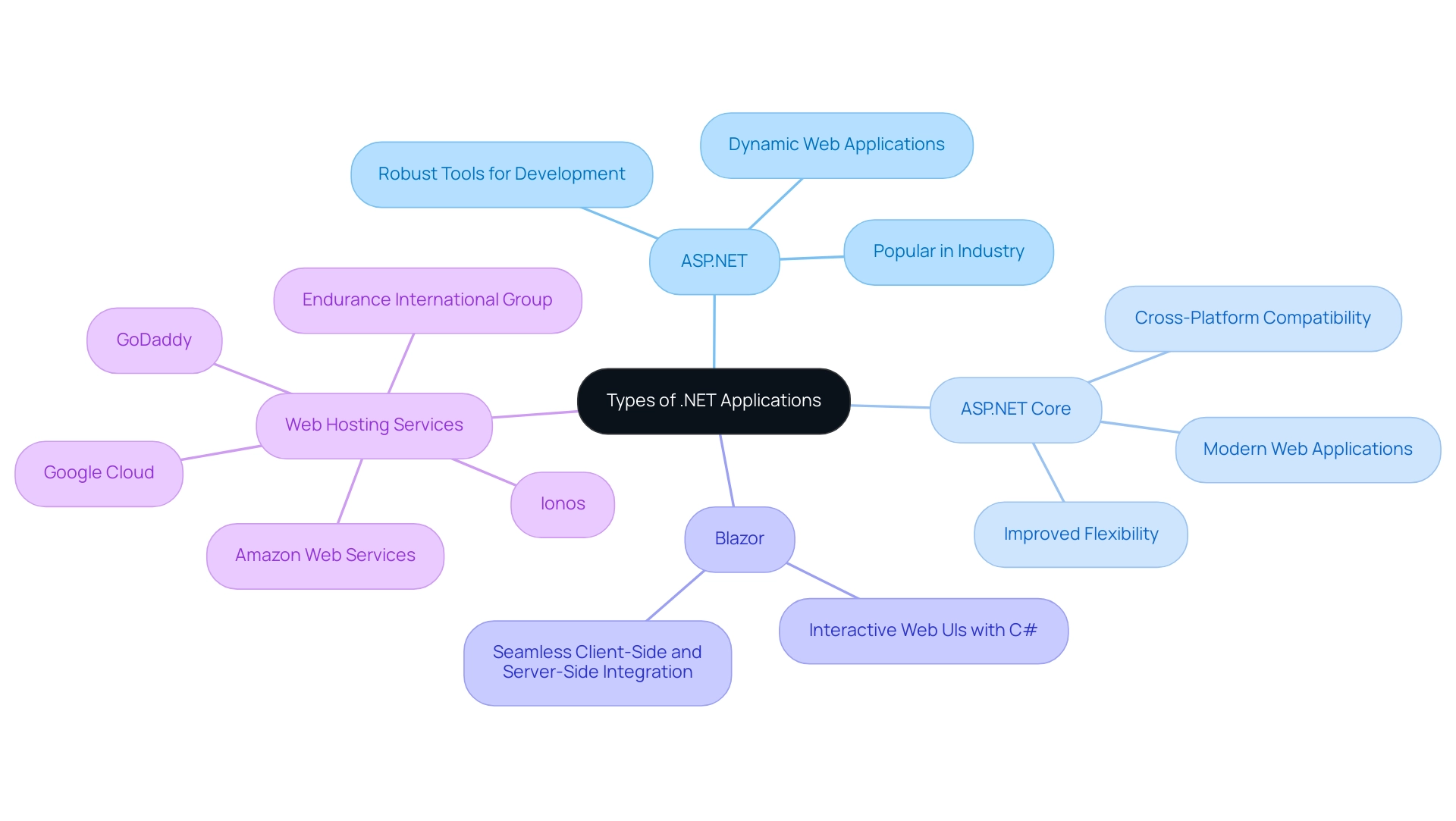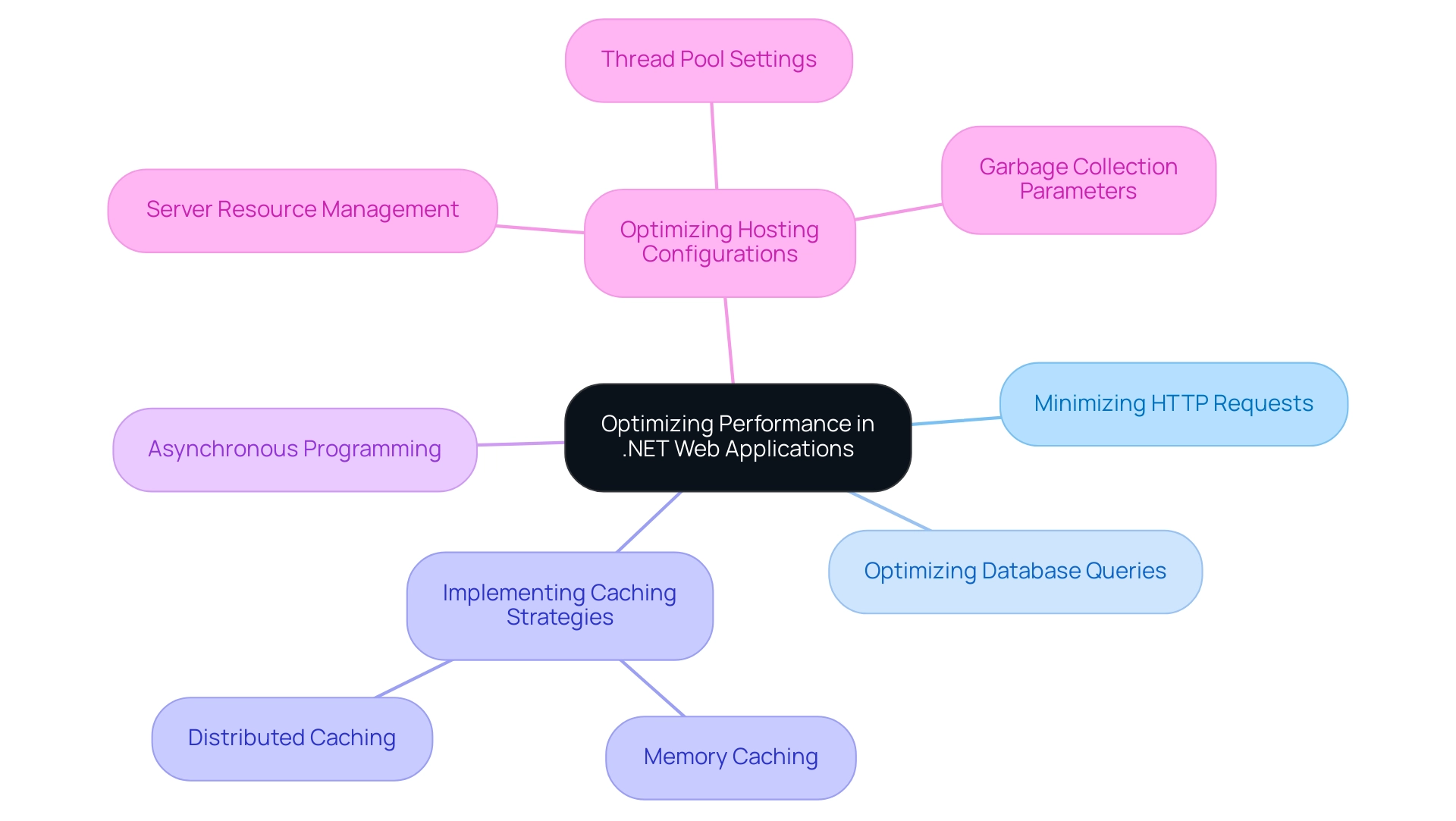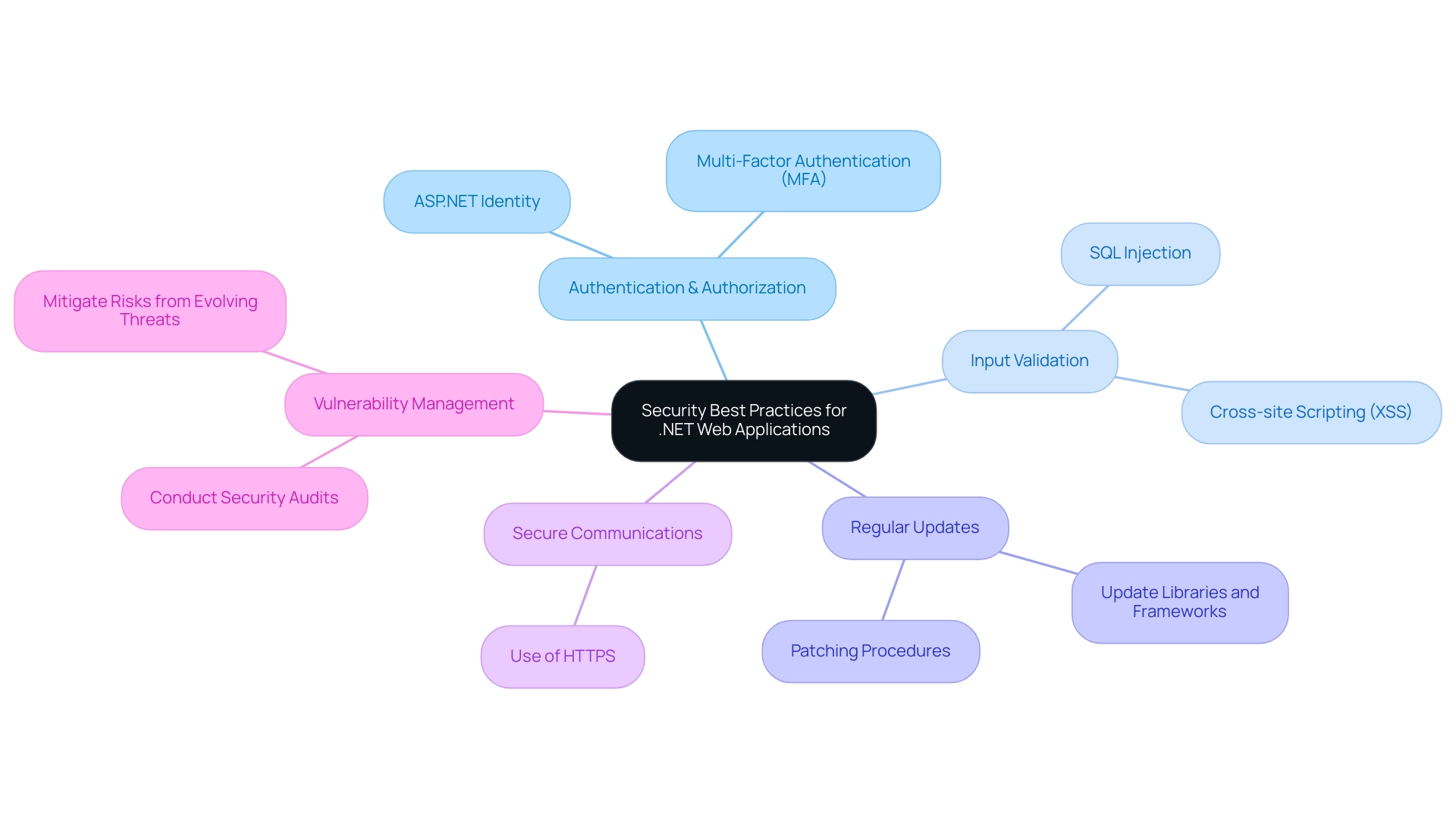Introduction
In the ever-evolving landscape of web development, .NET web applications have emerged as a cornerstone for creating dynamic and scalable solutions. As developers navigate the complexities of building modern websites and services, the .NET framework provides a robust environment complete with an extensive suite of tools and libraries. With its growing popularity in 2024, understanding the intricacies of .NET applications is paramount for developers seeking to deliver exceptional user experiences and manage data effectively.
From the versatile ASP.NET to the innovative capabilities of ASP.NET Core and Blazor, the framework offers unique strengths tailored to diverse project needs. This article delves into the various facets of .NET web applications, exploring essential tools, performance optimization techniques, and security best practices that will empower developers to harness the full potential of this powerful framework.
Introduction to .NET Web Applications
A web solution functions within the framework, enabling programmers to build dynamic websites and services with exceptional efficiency. This framework offers a comprehensive environment equipped with a diverse array of tools and libraries designed to streamline the development process. As of 2024, the framework continues to gain traction, reflecting a growing acceptance among programmers who appreciate its robust capabilities.
In fact, recent statistics show that web platforms are experiencing a considerable rise in usage, fueled by the need for dependable and scalable online solutions. Significantly, creators encounter obstacles such as a 57% average churn rate in the first month of an application, emphasizing the necessity of selecting a strong framework like ASP.NET to alleviate such problems. Grasping the nuances of .NET web systems is crucial for developers, as these systems not only facilitate seamless user experiences but also enhance effective data management.
Expert insights confirm the framework's crucial role, with industry leaders highlighting that its architecture supports complex functionalities essential for modern web systems. For instance, Joel Martinez notes,
'The observer pattern doesn't really fit here.
The functionality you describe should be captured using whatever model your software is utilizing. So for example, if you want to track the number of comments for each user, then that means you likely have a comments database table. You can simply write a SQL query that gives you a list of users and a count of the comments they have created in that table.'
This viewpoint highlights the framework's flexibility and adaptability in addressing specific usage needs. Furthermore, a committed group of ASP.NET specialists is ready to create and construct personalized software solutions designed for enterprise business requirements, demonstrating how companies can utilize specialized development services to achieve their distinct software and web project visions. Overall, the framework stands out as a vital resource for programmers aiming to realize innovative web solutions.

Exploring Different Types of .NET Applications
The NET ecosystem includes various software types, with ASP.NET standing out as a leading framework for developing dynamic net web applications and services. ASP.NET provides programmers with robust tools to create responsive and interactive websites, making it a popular choice in the industry.
In contrast, ASP.NET Core appears as a cross-platform framework designed for modern net web applications, allowing programmers to create software that is compatible across various operating systems, thus improving flexibility and deployment options. Blazor further innovates within this space by enabling the creation of interactive web UIs using C#, which allows for a seamless integration of client-side and server-side capabilities. Each of these frameworks presents unique strengths and specific use cases, necessitating careful consideration by developers when selecting the most suitable option for their project requirements.
Based on recent data, the market share of various software types continues to evolve, reflecting the increasing significance of connected devices and IoT platforms as highlighted in global surveys. For example, according to a recent report, well-known web hosting services comprise:
- Amazon Web Services
- GoDaddy
- Endurance International Group
- Ionos
- Google Cloud
This highlights the range of choices accessible for hosting software. As the web hosting sector expects to expand to $355.80 billion by 2029, propelled by rising digitalization, the need for dependable and innovative hosting solutions for net web applications created in these frameworks is crucial.
Therefore, grasping the subtleties of ASP.NET, ASP.NET Core, and Blazor is crucial for programmers seeking to utilize the complete capabilities of the framework.

Developing .NET Web Applications: Tools and Frameworks
Developing. The development of NET web applications necessitates the use of robust tools and frameworks, with Visual Studio standing out as a leading integrated development environment (IDE). Renowned for its comprehensive features, Visual Studio supports a seamless development experience, enabling programmers to efficiently create software.
ASP.NET Core is equally vital; it facilitates the creation of high-performance applications that align with modern web development practices. Furthermore, many programmers rely on Entity Framework for effective database management, providing a solid foundation for data manipulation. The incorporation of Razor Pages also allows for the creation of dynamic web pages, enhancing user interaction and engagement.
As noted by Mercy Nyamangwanda, Founder & CEO of KAI App USA,
Our team is always eager to create imaginative concepts,
underscoring the innovative spirit driving this technology. Notably, statistics reveal that 61% of all respondents spend more than 30 minutes a day searching for answers or solutions, highlighting the importance of efficient tools in development. Additionally, the evolving job market reflects an increase in median reported salaries for Nim, Erlang, and Apex professionals in 2024, indicating a competitive landscape that .NET specialists must navigate.
A practical example of a tool that enhances database querying and management is LINQPad, which enables programmers to write and test LINQ queries against various databases without a full IDE. Proficiency with these tools and frameworks is crucial for individuals aiming to provide efficient and scalable NET web applications, especially as the landscape changes in 2024.

Optimizing Performance in .NET Web Applications
Optimizing performance in .NET web applications is essential for ensuring responsiveness and scalability, especially as user demands and data loads increase. Techniques such as minimizing HTTP requests, optimizing database queries, and implementing effective caching strategies are fundamental.
Caching, in particular, plays a crucial role; adopting strategies like memory caching and distributed caching can significantly reduce load times and enhance user experience. As Mike Rousos aptly states,
This article provides guidelines for maximizing performance and reliability of ASP.NET Core apps.
Tools like Insights are invaluable for monitoring software performance, allowing developers to pinpoint bottlenecks and inefficiencies.
Furthermore, integrating asynchronous programming techniques enables systems to manage multiple requests simultaneously, resulting in improved responsiveness. An important aspect of achieving peak software performance is optimizing hosting configurations, including server resources. Recent case studies on server-side performance tuning highlight the significance of fine-tuning server configurations, such as thread pool settings and garbage collection parameters, to align with specific performance requirements.
By consistently observing server metrics, programmers can reveal chances for additional optimization, leading to a more scalable and high-performing system. Considering the fundamental importance of performance enhancement for business software, it is vital to apply these strategies to manage the increasing demands on systems efficiently.

Security Best Practices for .NET Web Applications
To ensure the security of web applications, developers must implement robust authentication and authorization mechanisms, notably through ASP.NET Identity for effective user management. Nivedita James Palatty, a technical writer with Astra, emphasizes the importance of safeguarding user data, stating that knowledge and curiosity drive better practices in software security.
Developers should prioritize validating and sanitizing user inputs to thwart prevalent vulnerabilities, including:
- SQL injection
- Cross-site scripting (XSS)
The necessity of regularly updating libraries and frameworks cannot be overstated, especially in a landscape where over 1,700 unique Common Vulnerabilities and Exposures (CVEs) have been reported exploited in the wild. Furthermore, employing HTTPS for secure communications and conducting thorough security audits will significantly enhance the overall security stance of systems.
As highlighted in the 2024 Threat Landscape case study, organizations must adopt strong vulnerability management and robust patching procedures to mitigate risks from evolving threat actors. The rise of new ransomware tactics and a 205% increase in cloud security issues in the public sector underscore the urgency of these actions. Developers should implement multi-factor authentication (MFA) and routinely assess their security protocols to address these pressing concerns.
By adhering to these guidelines, developers can create resilient applications that not only protect user data but also foster user trust and confidence.

Conclusion
The exploration of .NET web applications reveals their essential role in modern web development. With frameworks like ASP.NET, ASP.NET Core, and Blazor, developers are equipped with powerful tools to create dynamic, responsive, and scalable solutions. Each framework offers unique advantages, catering to a variety of project needs, while the continued growth of the .NET ecosystem underscores its significance in addressing contemporary challenges in web application development.
The importance of utilizing robust development tools, such as Visual Studio and Entity Framework, cannot be overstated. These tools streamline the development process, allowing for efficient application building and effective database management. Additionally, performance optimization strategies, including caching and asynchronous programming, are crucial for enhancing application responsiveness and scalability in an increasingly demanding digital landscape.
Security remains a paramount concern for developers working with .NET applications. Implementing robust authentication mechanisms, maintaining up-to-date libraries, and conducting thorough security audits are vital practices to safeguard user data and build trust. By adhering to security best practices, developers can ensure their applications are resilient against evolving threats.
In summary, mastering the intricacies of .NET web applications is indispensable for developers aiming to deliver exceptional user experiences and manage data effectively. As the digital landscape continues to evolve, embracing the full potential of the .NET framework will empower developers to create innovative, secure, and high-performing applications that meet the demands of today's users.





